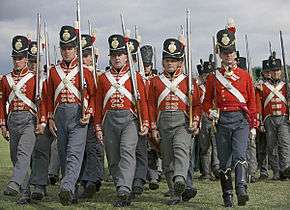Cross belt

A cross belt was a load-bearing device slung over the shoulder and trailed over the back and abdomen to rest on top of the opposite side hip. With nearly all line infantry, skirmishers, light infantry, grenadiers and guard regiments, the cross belt was worn in complement of another cross belt. The typical configuration for both cross belts was the cartridge box on the right hip and saber scabbard on the left. Both the scabbard and cartridge box were attached to the apex of the triangle formed where the cross belts' sides met. Officers did not carry muskets or rifles, and as such typically would only wear 1 cross belt - for the pistol cartridge box. However, due to the aristocratic status of many officers, and their pride in their rank and command, their uniforms and gear organisation were highly variable.[1]
For British infantry, the cross belts had a metal belt plate with the regiment of the soldier inscribed on it.[2]
Time period
The cross belt was predominantly used from the 1700s (American Revolutionary War) to the 1840s (the were not part of a soldier's equipment in the American Civil War and Anglo-Zulu War/1st Boer War).